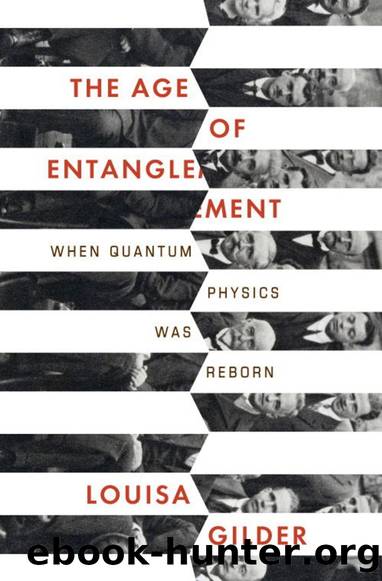The Age of Entanglement: When Quantum Physics Was Reborn by Louisa Gilder

Author:Louisa Gilder [Gilder, Louisa]
Language: eng
Format: epub
ISBN: 9781400044177
Google: 5i4isqpu-I8C
Amazon: 1400095263
Barnesnoble: 1400095263
Goodreads: 5096882
Published: 0101-01-01T00:00:00+00:00
Epilogue to the Story of Bohm
1954
IT TOOK A LONG TIME for Bohm to forgive Oppenheimer, and it certainly did not happen until Oppenheimer had more or less destroyed himself during his appearance before the House Un-American Activities Committee. By all accounts, he came out a shattered man, and was perhaps easier to forgive that way.
But in 1954, Oppenheimerâs troubles were only beginning, and Bohm wrote to Miriam, I have just heard from a friend that J.O. may be called before a committee soon (of course he has ways of getting out of it perhaps)â¦[Itâs all going to happen to] the great man himself, whose face once appeared with infinite sadness on the cover of Time Magazine. Perhaps he
will really have reason to be sad too. As I once said, he looked like Jesus Christ in the picture.
I think a better image would be a linear combination of J.C. and Judas, or of Judas trying to look like J.C. An interesting case of mistaken identification, donât you think?
Bohm taught in Israel, and then, ever unsatisfied, in 1957 moved on to Britain, with a favorite, brilliant grad student from the Technion at Haifa, Yakir Aharonov, following close behind. Though his papers with Aharonov are well respected for the gains they represent in physical understanding, his interests (communism finally renounced) began to turn toward mystical philosophical musings, sitting at the feet of the guru Krishnamurti. His vision of the world became ever more abstract (and ever more popular with the public). He propounded, with his gently fluttering hands and earnest face, complicated ideas with broad strokes and beautiful (if somewhat vague) words.
âI would say,â wrote Bohm in the introduction to his best seller, the philosophico-physical book Wholeness and the Implicate Order, âthat in my scientific and physical work, my main concern has been with understanding the nature of reality in general and of consciousness in particular as a coherent whole, which is never static or complete, but which is an unending process of movement and unfoldment.â
Feynman would become even more wildly popular.
In November 1964, he returned to his old snowy stomping grounds in Ithaca to give Cornellâs annual âMessenger Lecturesâ for the general public on the subject âThe Character of Physical Law,â
which were subsequently made into a book. With his clarity, his humor, his accent undiminished in spite of years of living far from Brooklyn, he charmed and inspired the crowds that packed into the lecture room to watch him cavort across the stage below them. The lectures displayed his love of Nature itself, of the way things really work, of the specific, the actual, the find-out-able, and they gave an overview of how one of the greatest physicists of his generation thought about his subject.
The sixth lecture was titled âProbability and Uncertainty.â Now was the time to talk about quantum mechanics, where, he told his listeners, âour imagination is stretched to the utmostânot, as in fiction, to imagine things which are not really there, but just to comprehend those things which are there.
Download
This site does not store any files on its server. We only index and link to content provided by other sites. Please contact the content providers to delete copyright contents if any and email us, we'll remove relevant links or contents immediately.
The Complete Stick Figure Physics Tutorials by Allen Sarah(7310)
Secrets of Antigravity Propulsion: Tesla, UFOs, and Classified Aerospace Technology by Ph.D. Paul A. Laviolette(5309)
Thing Explainer by Randall Munroe(3877)
The River of Consciousness by Oliver Sacks(3542)
The Order of Time by Carlo Rovelli(3145)
How To by Randall Munroe(3036)
A Brief History of Time by Stephen Hawking(2962)
I Live in the Future & Here's How It Works by Nick Bilton(2938)
The Great Unknown by Marcus du Sautoy(2648)
What If?: Serious Scientific Answers to Absurd Hypothetical Questions by Randall Munroe(2637)
Midnight in Chernobyl by Adam Higginbotham(2483)
Blockchain: Ultimate Step By Step Guide To Understanding Blockchain Technology, Bitcoin Creation, and the future of Money (Novice to Expert) by Keizer Söze(2449)
Networks: An Introduction by Newman Mark(2360)
The Meaning of it All by Richard Feynman(2300)
Easy Electronics by Charles Platt(2282)
The Tao of Physics by Fritjof Capra(2231)
Midnight in Chernobyl: The Untold Story of the World's Greatest Nuclear Disaster by Adam Higginbotham(2177)
When by Daniel H Pink(2083)
Introducing Relativity by Bruce Bassett(2080)
